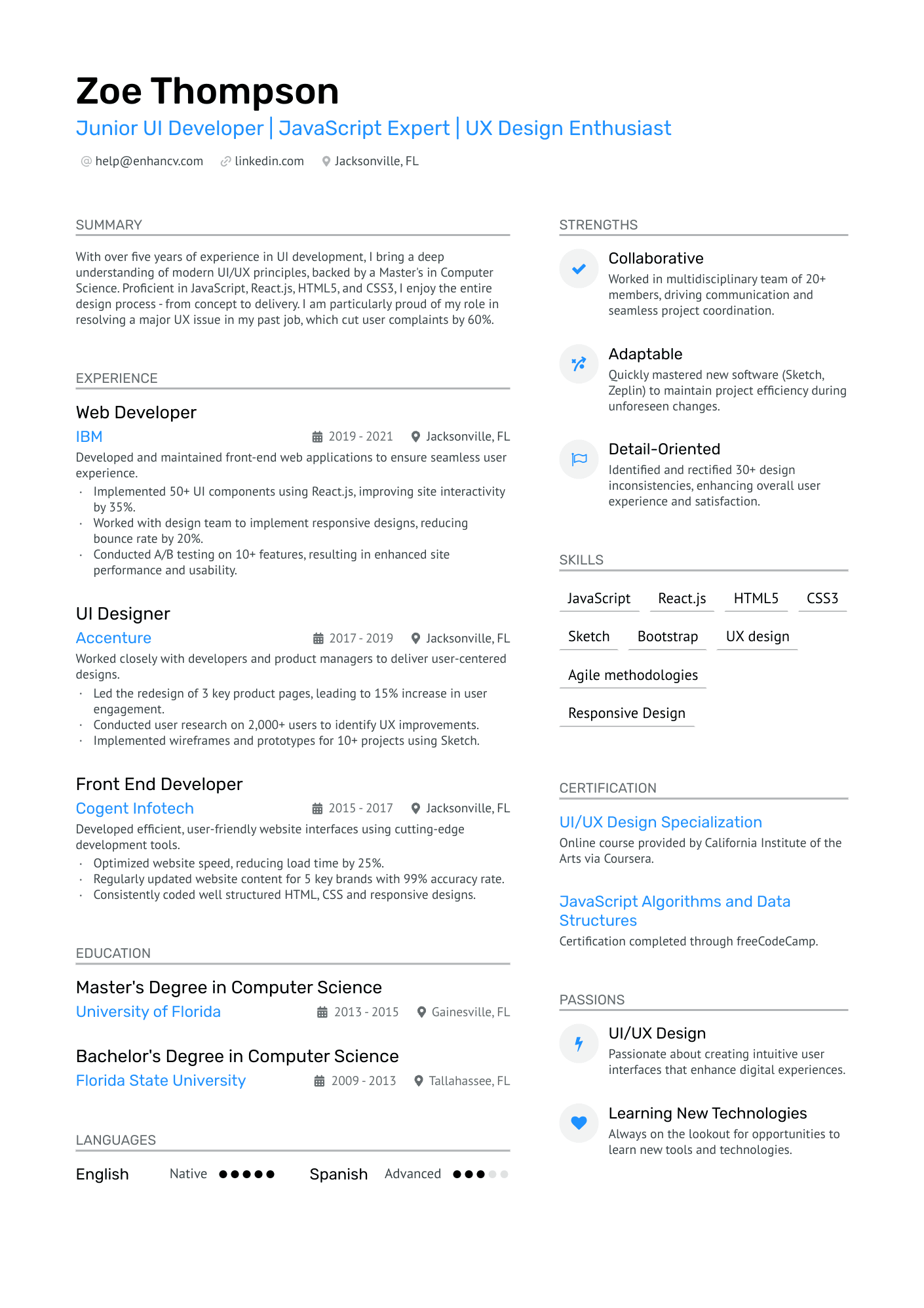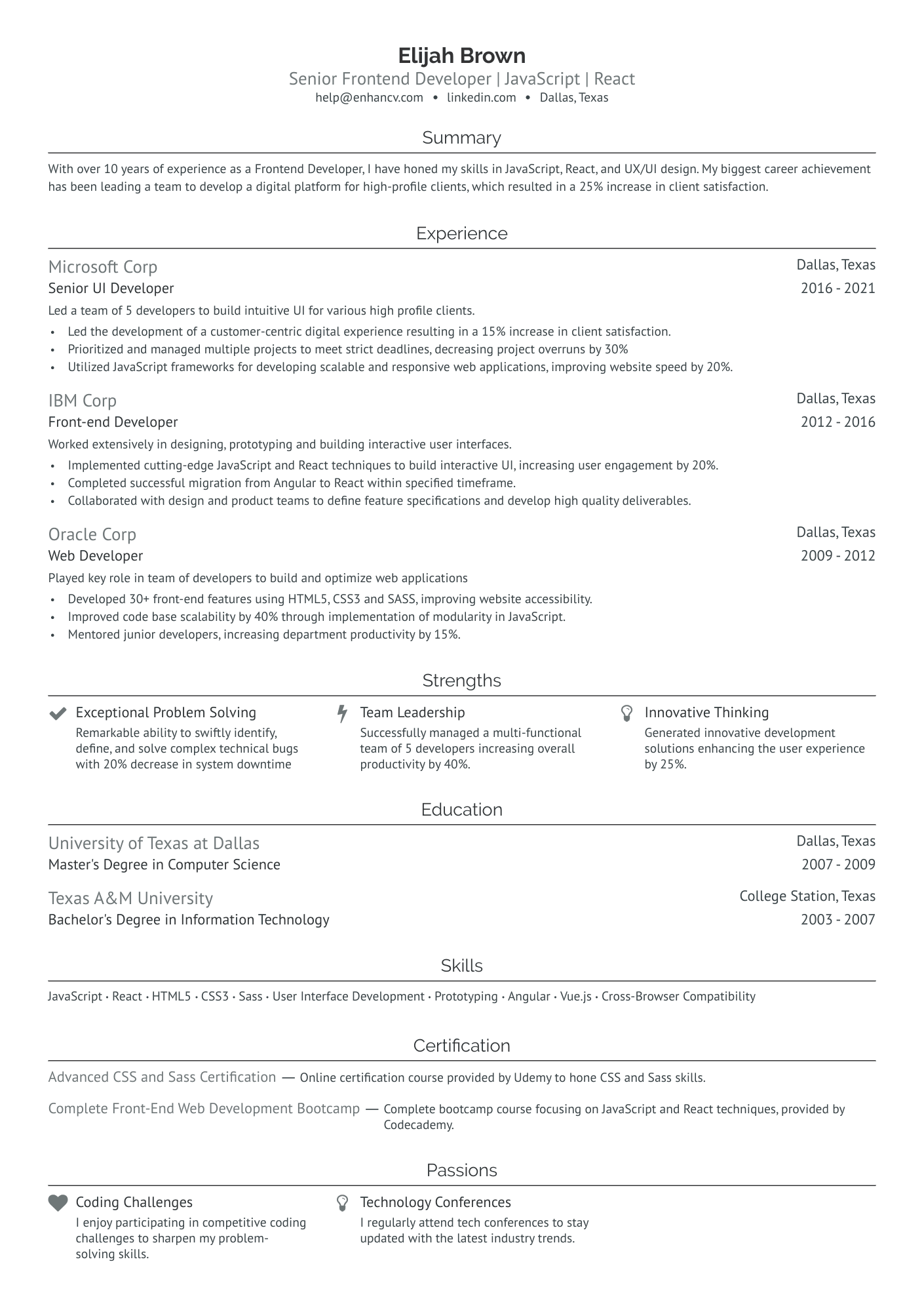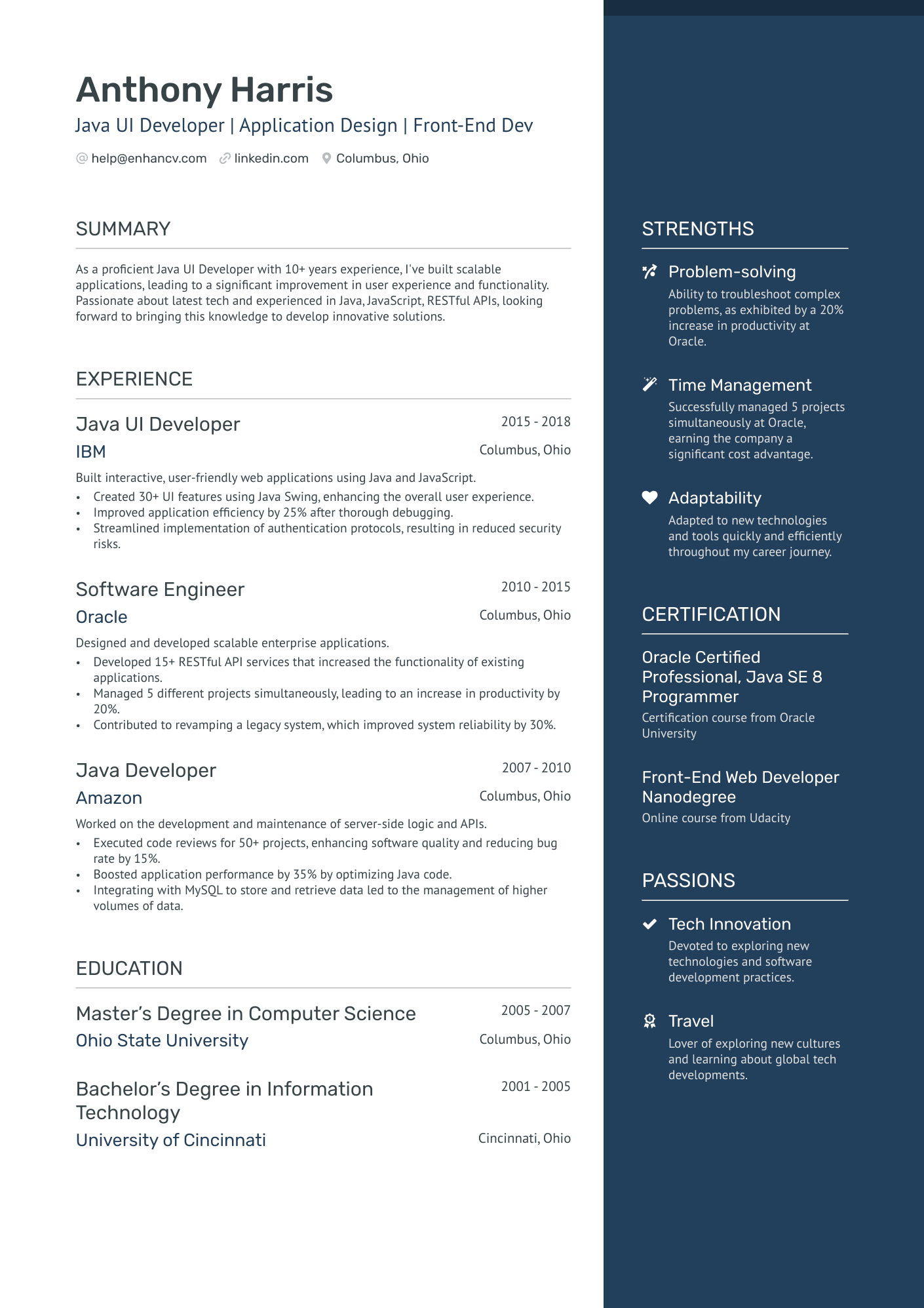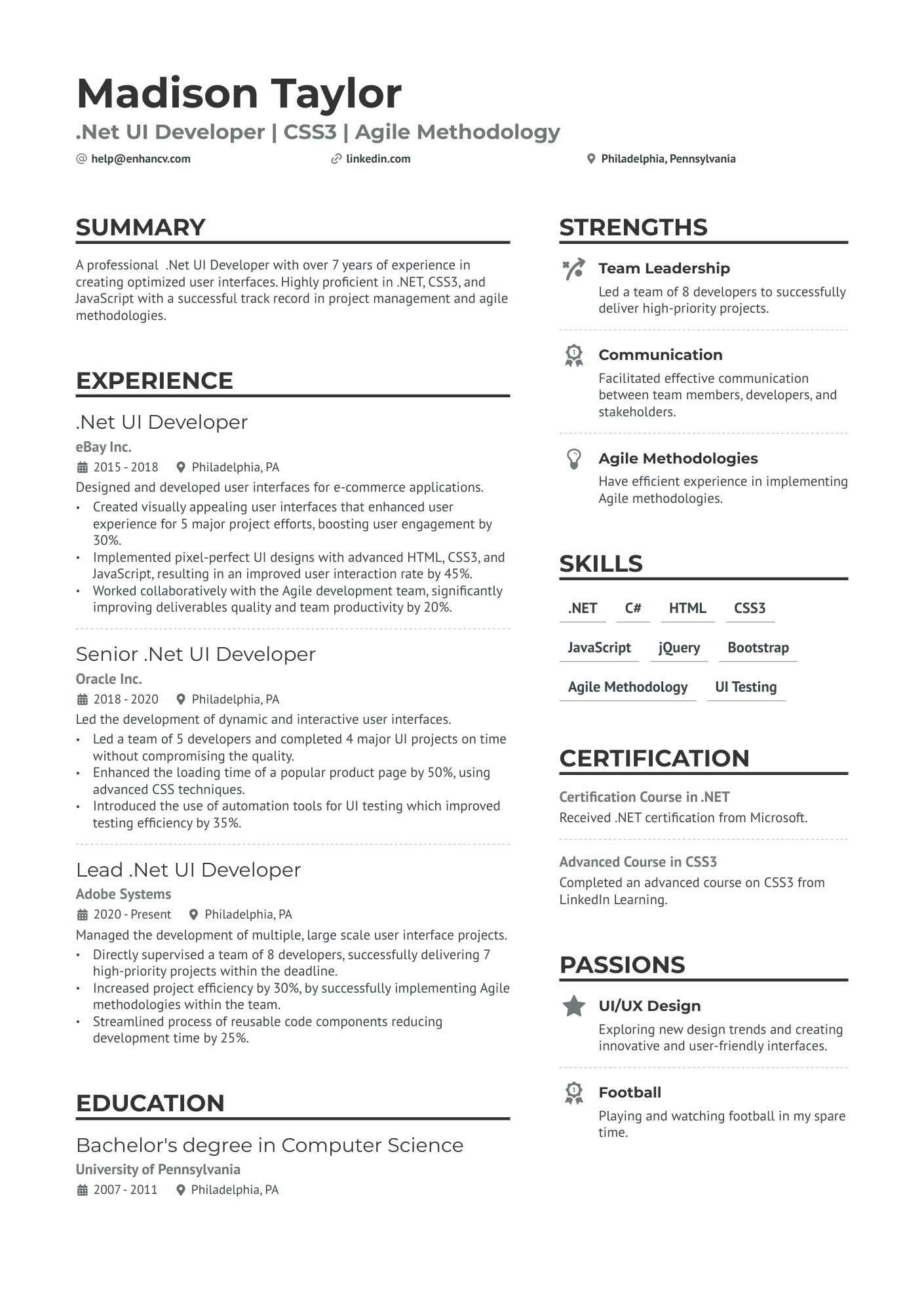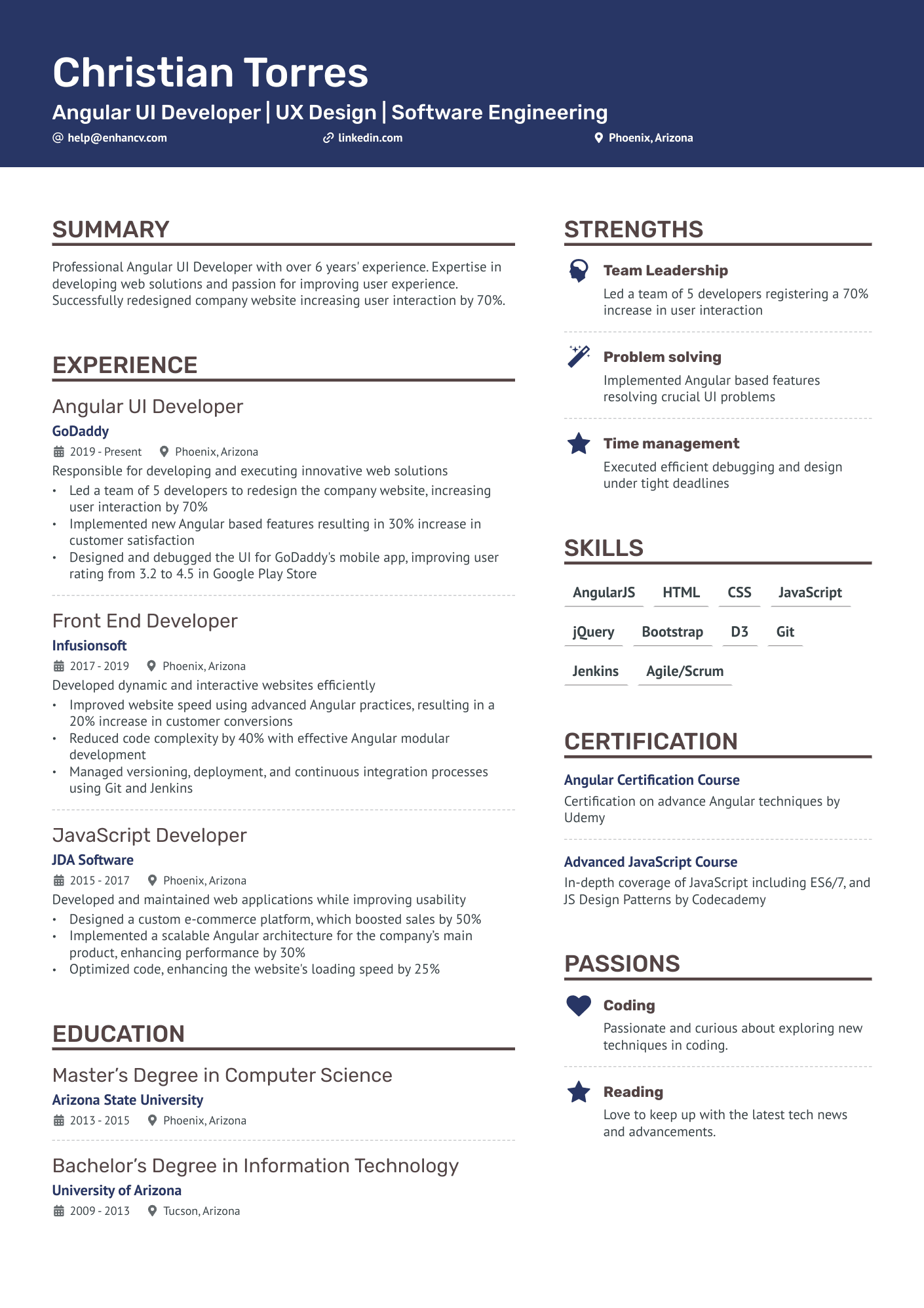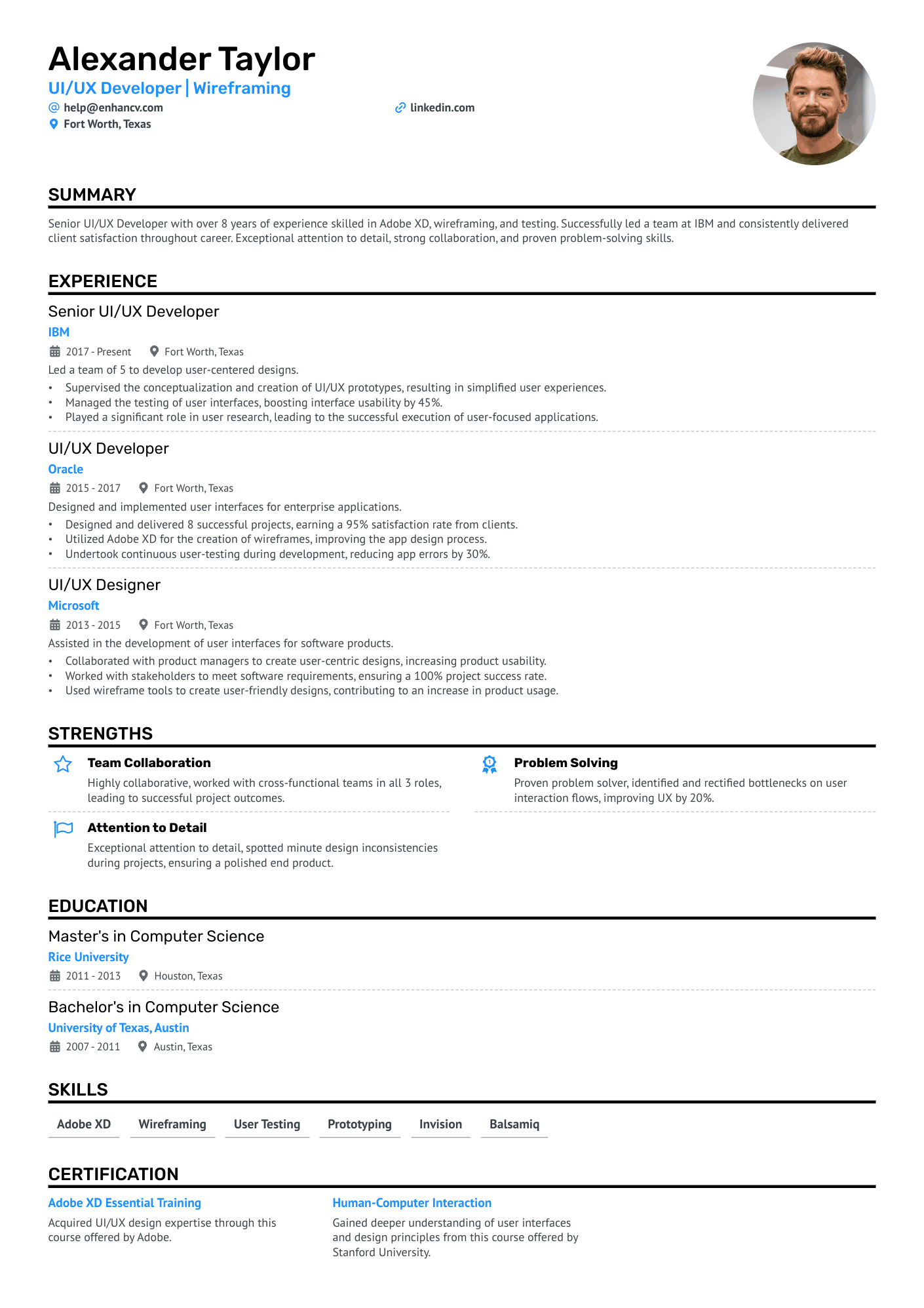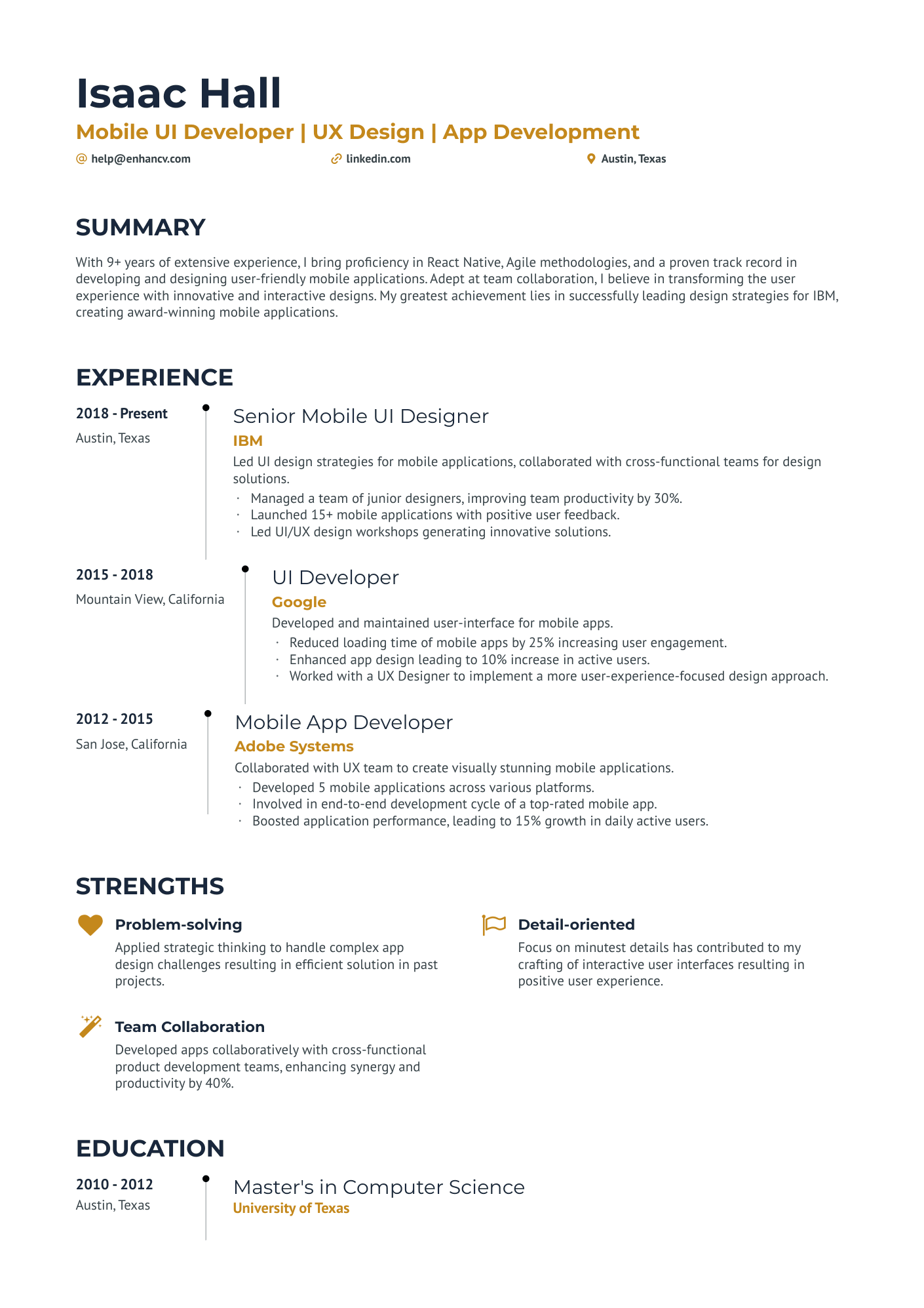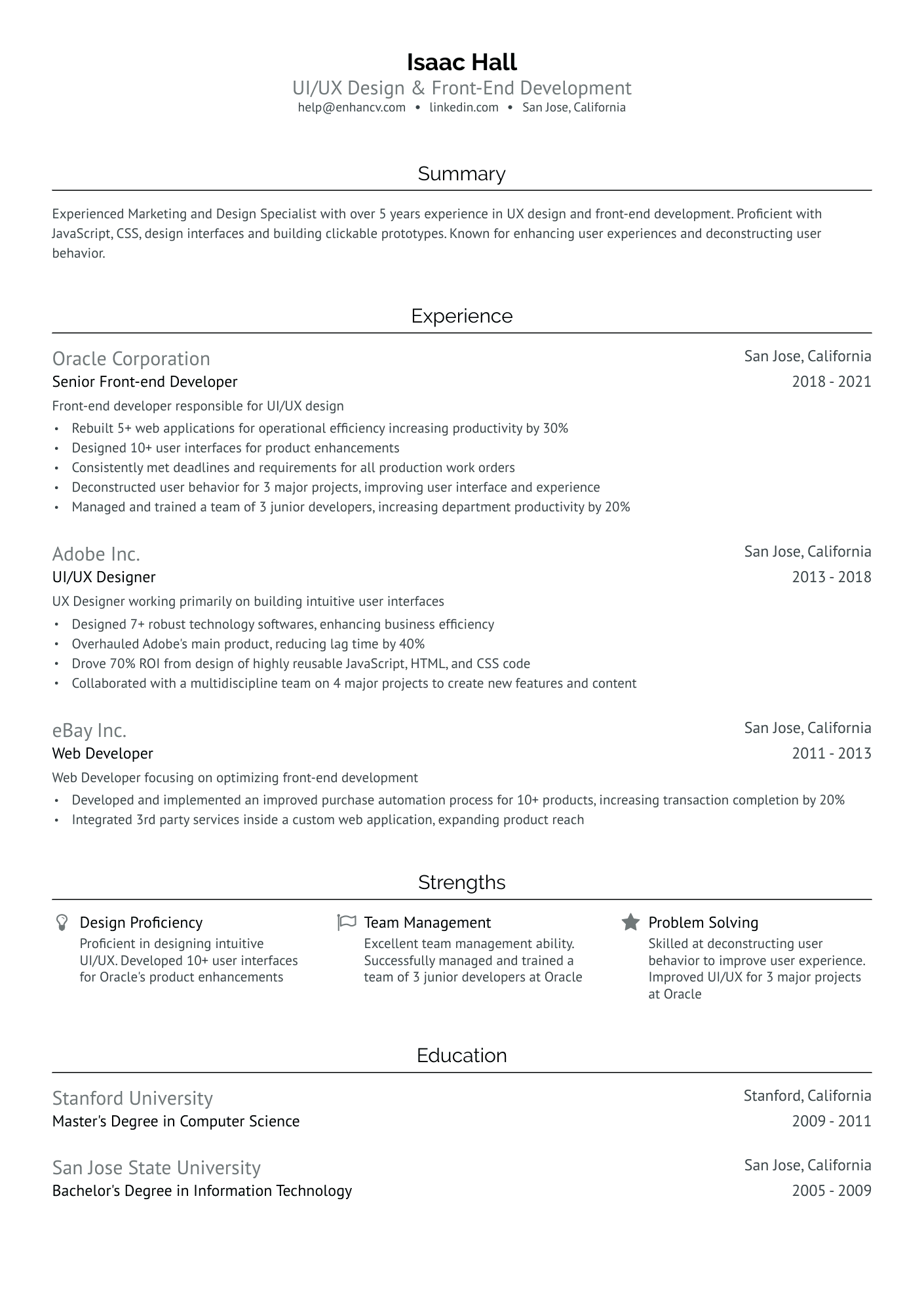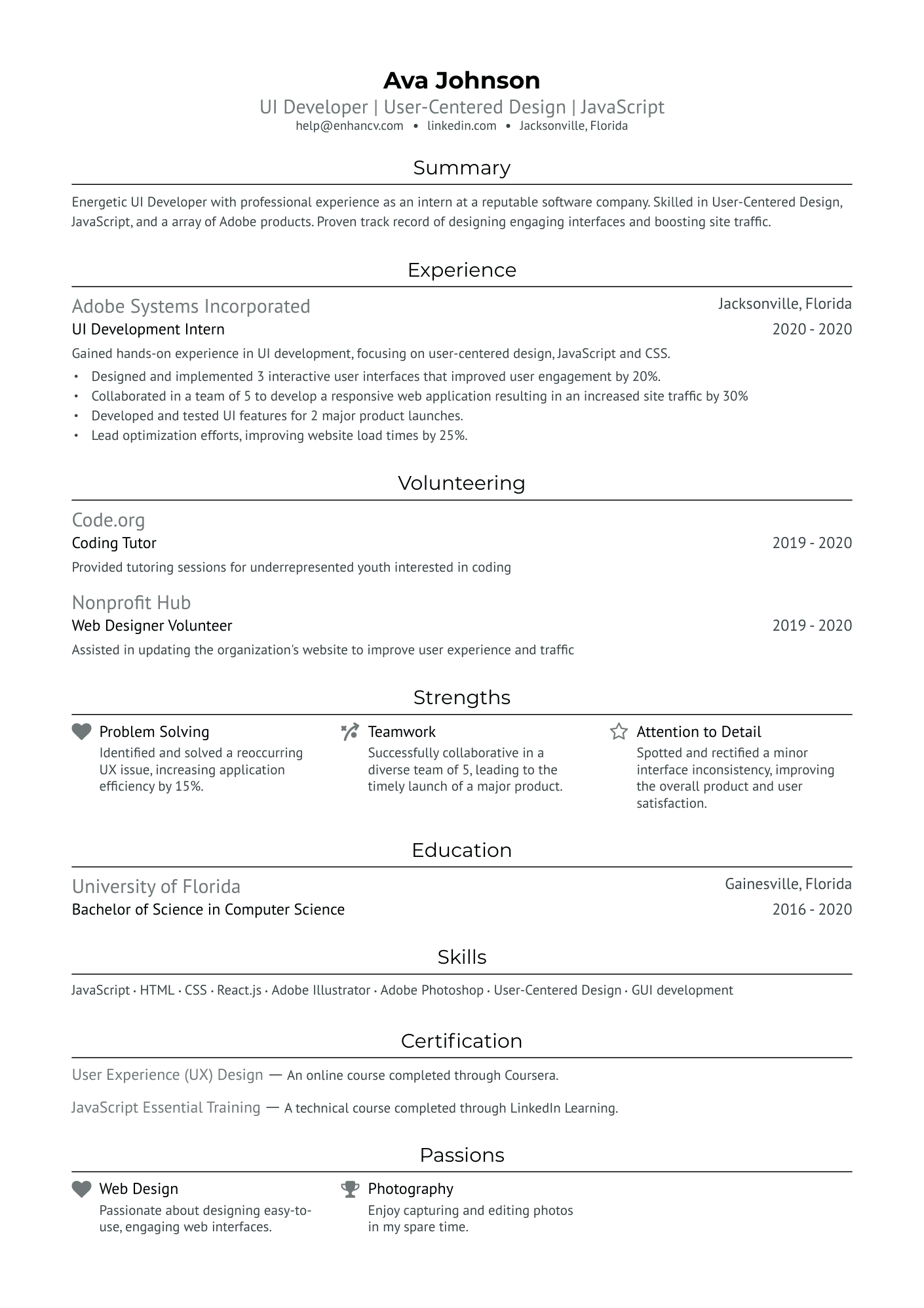User Interface is where art and technology meet. It requires a unique blend of technical skills for front-end development as well as creative skills needed for design.
For many UI developers, this fusion ofskills is one of the most appealing aspects of the career. You can apply many of the same principles that balance creativity and function when developing a user interface to make writing your UI developer resume less tricky. In particular, UI developers struggle with the following:
- Striking a balance between technical and creative abilities.
- Determining your most valuable skills to emphasize.
- Demonstrating ability without prior UI development employment.
- Reinforcing stated skills by showcasing tangible work samples and using quantitative evidence.
This resume guide, including examples and pro tips, addresses all of these challenges and more, enabling you to create an appealing UI developer resume that gets noticed by employers seeking talented and knowledgeable UI developers.
For additional related resume examples, be sure to check out the following:
- UX Researcher resume
- UX/UI Designer resume
- Front-End Developer resume
- Interactive Designer resume
- UI developer cover letter
How to format a UI developer resume
“Know your audience” is the UI design principle you will want to consider when formatting your resume. Knowing your audience allows you to communicate more effectively which is why a targeted resume is always more effective than a generic one.
To target your UI developer resume you will need to tailor it to the target audience, the employer, for each application. Consider what would be most appealing to the particular field or company based on your own research and information provided in the job post.
When targeting your resume’s formatting remember to utilize these formatting best practices:
- Creative elements: Make your resume unique and memorable by including creative elements, such as colors, patterns, or a header photo. However, avoid creative elements within the text, such as emojis and non-standard date formats. These can impede an ATS' ability to recognize the text. Therefore, standard formatting is vital within the text sections of your resume.
- Font selection: Font Selection: Select ATS-friendly fonts that match the overall theme of your resume. Examples of ATS-friendly fonts are Serif and Sans-serif, Aria, and Times New Roman. However, these can also be overused. For more creative options available on the Enhancv Resume Builder, try Rubik, Lato, Montserrat, Raleway, Exo 2, and Volkhov.
- Header content: Include a prominent header featuring your name, desired job title, and contact information (phone number and email address) to ensure the information is easily readable.
- Section headings and subheadings: Ensure all resume sections are logically organized and include clear, accurate headings.
- Ordering: When listing any items, always use reverse chronological order, putting your most recent and relevant examples at the top.
- Document type: PDF files are standard for resumes since they maintain formatting across software and are easily analyzed by ATS.
The layout of a resume can differ by region – Canadian resumes may use a distinct format.
Is your resume good enough?
Drop your resume here or choose a file. PDF & DOCX only. Max 2MB file size.
Be sure to include these top sections for UI developers to enhance ATS analysis of your resume and ensure employers can easily spot your best qualifications.
The top sections on a UI developer resume:
- Technical skills: This validates your technical competency and proficiency in key UI development tools and languages.
- Portfolio/links to work: Showcasing previous UI development projects substantiates your experience and exhibits your creative ability.
- Professional experience: This allows recruiters to review your past roles and understand your responsibilities, achievements, and the technologies you have worked with.
- Certifications/courses: These can demonstrate your commitment to learning and staying updated in the rapidly evolving UI development field.
- Professional summary: This provides an opportunity to highlight your key skills, experience, and career aspirations in UI development.
The broad range of skills and qualifications required for UI developers can pose a challenge when determining what to include on your resume. Use these top skills and abilities recruiters value as a guide to get you started.
What recruiters want to see on your resume:
- Knowledge of coding languages: Recruiters prioritize this because UI developers need to code the visual end of the interface, using languages like HTML, CSS, and JavaScript.
- Proficiency in UI/UX design principles: It's necessary in this role to understand and utilize these principles to create an intuitive, user-centered design.
- Experience with visual design tools: Familiarity with tools like Sketch, Adobe XD, or Figma is a must-have as they are commonly used in the creation and prototyping of UI elements.
- Understanding of responsive design: Recruiters prioritize this because UI developers need to ensure that the user interface looks good and functions well on all devices and screen sizes.
- Familiarity with version control/git: This is important as UI developers often work as part of a team and need to manage and keep track of changes to the codebase efficiently.
How to write your UI developer resume experience
Employers want to know you don’t simply understand the skills required for user interface development but that you have successfully utilized them to create finished products. The experience section of your UI developer resume should showcase your development of critical skills such as front-end development skills and achievements made in past roles.
A common mistake is to simply list job duties performed in past jobs. An effective experience section should be tailored to the desired position and demonstrate specific transferable skills. To accomplish this, you must create a targeted resume by selecting desirable keyword skills and abilities from the job posting for the new position and selecting prior work that demonstrates them.
The following example indicates how an experience section is improved by describing achievements as opposed to duties.
- •Converted design files from Adobe XD into functional user interfaces using HTML, CSS, and JavaScript.
- •Ensured web applications were responsive and functional across various devices and screen sizes, using responsive web design principles.
- •Worked with UX designers to translate wireframes and prototypes into interactive, user-friendly interfaces.
- •Updated and refined user interface of existing applications, improving usability and incorporating new features as required.
This applicant describes many duties required in nearly all UI developer positions. However, they don’t clarify how successful they were in this role or what accomplishments they achieved. This presentation fails to grab the attention of a potential employer or stand out among other applicants.
- •Led a redesign of the flagship product’s interface, enhancing the user experience and modernizing the look and feel, resulting in a 30% increase in user engagement and a 25% decrease in customer support inquiries related to usability.
- •Implemented a responsive design for the company’s main e-commerce platform, making it fully compatible across a variety of devices and screen sizes utilizing CSS3, HTML5, and JavaScript, along with the Bootstrap framework, leading to a 40% increase in mobile traffic.
- •Actively participated in Agile/Scrum meetings, contributing to sprint planning, retrospectives, and daily stand-ups, ensuring that UI development efforts were aligned with team objectives and timelines.
This improved experience description illustrates many of the same responsibilities but adds credibility to the applicant's success in the role by including quantitative data, using action verbs, and detailing their achievements.
How to quantify impact on your resume
It's clearly more compelling to state that you have 'experience implementing responsive design' when you can back it up with the fact that your efforts 'resulted in a significant 40% increase in mobile traffic ', as demonstrated in the experience example above.
Quantifiable data, such as numbers or percentages, is an excellent way to evidence your ability to create user-friendly and engaging applications and write functional, scalable front-end code.
Here are a few examples of ways to include numbers and statistics to quantify your impact in past UI developer jobs:
- Showcase your experience and productivity in the field by including the number of projects you worked on.
- Highlight your capability to handle projects impacting a large user base by mentioning the scale of users impacted by your prior efforts.
- Demonstrate your impact on business outcomes and user experience by showcasing significant increases in user engagement resulting from your UI designs.
- Illustrate technical efficiency and user-centric focus by stating efficiency gains resulting from your work, such as decreased load times.
- Indicate your ability to work as part of a diverse and dynamic team by including the number of cross-functional teams you've collaborated with and the size of the teams.
- Share your capacity to drive business objectives through user interface development by mentioning your designs that increased conversion rates.
- Indicate your versatility and adaptability in using different design platforms by stating the number of design tools you're proficient in.
- Demonstrate the complexity of past projects tackled, such as the number of pages or features implemented, to demonstrate your problem-solving skills and ability to handle complex assignments.
Incorporating these strategies into your UI developer resume showcases your skills and provides employers with a clear understanding of your transferable skills based on past achievements.
How do I write a UI developer resume with no experience
There are numerous options for demonstrating your potential for success as a UI developer without prior UI development experience. For example, many related careers in software development can establish mastery of transferable skills. Additionally, self-taught skills or those acquired through formal education can be illustrated in other resume sections.
To communicate qualifications and achievements without prior UI developer employment, follow these steps:
- Compile a list of keywords from the job description.
- Brainstorm previous experiences that showcase the same keyword skills and knowledge from your list. These could be school experiences, internships, freelancing, or working on personal projects.
- Provide samples of your work in a projects or portfolio section whenever possible.
- To add credibility, include tangible evidence of transferable skills, such as relevant education and certifications.
- Include quantifiable data to demonstrate your efficacy in related roles.
- Avoid including irrelevant work experiences or outdated experiences.
- Always list experiences in reverse chronological order to ensure your most recent and relevant examples appear first.
PRO TIP
It's common for entry-level applicants to feel their experience section isn't strong enough. Rather than attempting to include irrelevant work examples to incorporate relevant achievements, consider incorporating additional sections better suited to sharing the qualifications, such as an awards, projects, or publications section.
How to list your hard and soft skills on your resume
UI developers require a multitude of hard skills related to app development, such as UX knowledge and front-end development skills. However, it is equally important to include soft skills demonstrating your dedication to hard work and your commitment to the profession. Your resume’s skills section serves as a quick reference to highlight traits and abilities that indicate your overall suitability for a position.
You must create a thorough but targeted skills section to ensure your qualifications are clear to recruiters at a glance.
Follow these steps to write your targeted skills section:
- Format your skills section as a simple list without elaboration or examples.
- Include hard and soft skills, differentiating between them by listing them separately.
- Target your list for individual positions by including keyword skills directly from the job description.
- Write your keyword skills precisely as they appear in the job description to enhance ATS optimization.
- Never lie about or exaggerate your skills.
- Keep your experience and skills sections consistent. List the skills mentioned in the experience section on your skills list and demonstrate how you’ve developed skills in your experience descriptions.
Presenting relevant hard and soft skills on your resume gives employers a more holistic idea of who you are as an employee and what data analysis skills you will contribute.
Hard skills
Technical skills that require study, training, and practice are known as hard skills. In UI development, these include programming and coding skills and knowledge of development software.
When considering which hard skills to include on your resume, consult this list of the top hard skills for UI developers:
Best hard skills for your UI developer resume
- HTML5
- CSS3
- JavaScript
- jQuery
- React.js
- Angular.js
- Bootstrap
- Sass
- Adobe Creative Suite
- Figma
- Sketch
- Wireframing and prototyping
- Git and GitHub
- TypeScript
- AJAX
- JSON
- Vue.js
- Node.js
- User Experience (UX) Design
- User Interface (UI) Design
Soft skills
Soft skills are an often overlooked but potentially valuable resume asset. They are intrinsic, personal skills that make you uniquely qualified to succeed in a role. For example, attention to detail and creativity are vital soft skills for UI developers to create an appealing and functional application.
Soft skills are transferable from one job to another but are difficult to teach due to their intrinsic nature. Therefore, these skills provide an incredible opportunity to distinguish yourself from other candidates.
These are some of the top soft skills employers look for in UI developers:
Best soft skills for your UI developer resume
- Communication
- Creativity
- Collaboration
- Attention to detail
- Empathy
- Problem-solving
- Critical thinking
- Time management
- Patience
- Adaptability
- Open-mindedness
- Proactivity
- Ability to take feedback
- Decision-making
- Strategic thinking
- Leadership
- Multitasking
- Customer service
- Dedication
- Flexibility
How to list your certifications and education on your resume
UI development is an ever-evolving field with constantly emerging tools, conventions, and libraries.
Your resume’s education and certifications sections are excellent ways to demonstrate your foundational knowledge and commitment to continued learning and keeping current in the field.
Your education section allows you to demonstrate a foundational knowledge in hard skills related to design and development. “UI roles may require a bachelor's degree in graphic design, art, web design or a related field.“
To write your UI developer education section, follow these steps:
- List degrees in reverse chronological order to ensure your most recent and relevant degree appears first.
- For degrees, include the name of the university, its location, and the title of your degree. Including your GPA is optional unless a specific minimum GPA is specified in the job description.
- Only include your major and minor if relevant to the position or provide pertinent information about your background. For example, a minor in graphic design would be highly appropriate, while a poetry minor would not.
- Mention highly relevant coursework in the bulleted education description.
The following is an excellent example of an education section for a UI developer’s resume.
- •Minor in Graphic Design
Certifications hold significant value on UI developer resumes, irrespective of experience level. They serve as a powerful tool to showcase hard skills and knowledge, especially for those without work experience or a related degree. For seasoned UI developers, certifications demonstrate a proactive commitment to staying updated in the ever-evolving field, enhancing their professional credibility.
To write your UI developer certifications section, follow these steps:
- Limit certifications to current, unexpired credentials.
- Include the name of the certification, the certifying institution, and the year obtained. The year is significant for tech-related certificates since substantial changes or updates may have occurred since it was obtained.
- Limit your certifications to only those specifically mentioned or related to skills from the job description.
Many institutions, like LinkedIn Learning, Udacity, and Coursera, offer relevant certifications for UI developers. Additionally, here are a few of the top UI developer certifications currently sought by recruiters.
Best certifications for your UI developer resume
- Adobe Certified Expert (ACE): Adobe Certified Expert in Photoshop, Illustrator, or XD
- Microsoft Certified: Azure Fundamentals: Microsoft Azure Fundamentals
- Google UX Design Professional Certificate: Google UX Design
- CIW Web Design Specialist: Certified Internet Web Professional - Web Design Specialist
- Interaction Design Foundation (IDF) Membership: Access to all IDF courses in UX Design
How to write your UI developer resume summary or objective
Personal Statements, such as a summary or objective, serve as concise introductions highlighting your UI development skills, experiences, and career goals. They are your first opportunity to make a strong impression on potential employers and set the tone for the rest of your resume.
These statements are vital for UI developers who may have a variety of education and experiences. If your career trajectory is not well established or evident, these sections allow you to highlight well-aligned and transferable skills and experiences to clarify your suitability for an available job.
The primary difference between a summary and an objective is that a summary statement focuses on how past employment experiences align with an available job. In contrast, an objective statement concentrates on your future career goals to illustrate how they correspond with the position.
An objective section is preferable for an entry-level data UI developer since applicants have limited experience in the field.
Follow these best practices to write your UI developer objective statement:
- Customize the statement to match the specific job you're applying for, emphasizing relevant keyword skills and knowledge directly from the job description.
- Describe the kind of position you are seeking.
- Mention relevant, transferable soft skills you hope to use as a UI developer.
- Highlight your motivation to learn and gain experience.
- Start sentences with action verbs to make your summary dynamic and impactful.
- Be brief. Keep your objective to 3-5 sentences.
A summary is preferable for UI developers with extensive experience in similar roles to the available position. A summary highlights how your background indicates suitability and potential success.
To write a UI developer resume summary, follow these best practices:
- Highlight relevant keyword skills and experience that directly overlap with the new role.
- Make your statement impactful by using keywords directly from the job description.
- Showcase achievements made in past jobs that evidence your success in the role.
- Utilize quantitative evidence when possible to reinforce stated achievements.
- Start sentences with action verbs to make your summary dynamic and impactful.
- Be brief. A summary should be between 3-5 sentences.
An effective strategy to stand out among other applicants is to tailor your summary to the desired position. This example demonstrates how a summary becomes more impactful when targeted to a particular position.
While this summary statement meets several best practices, the overall message is generic. It lacks specifics, such as examples of web technologies and design principles they are proficient in. It also fails to include specific achievements or quantitative evidence of their impact. Lastly, the scarcity of active verbs and keywords contributes to the overall nonspecific and unintriguing feel.
This summary would be more memorable and give a clearer impression of the applicant's skills and abilities. By naming specific technologies and using keywords from the job description, the impact of the summary is improved. They also include quantitative data to evidence their ability to increase user engagement. The resulting summary would be more likely to grab the attention of recruiters.
PRO TIP
Rephrasing specifics from the “Qualifications” or “Ideal Candidate” sections of a job description is a great way to guarantee you mention the skills and qualifications most valued by the employer.
Additional sections for a UI developer resume
Considering which sections to include among the various parts of your UI developer resume can be challenging. However, additional non-standard resume sections are useful for including relevant skills or experiences that don't fit among your resume's top resume sections. Here are a few examples of additional resume sections relevant to UI developers in particular.
- Languages: A languages section is highly relevant in UI development. Today's workforce is increasingly global. Therefore, fluency in multiple languages can be a valuable asset that sets you apart from other applicants.
- Programming Languages or Frameworks: If you're proficient in multiple programming languages or frameworks beyond the standard HTML, CSS, and JavaScript (e.g., TypeScript, SASS, Bootstrap), consider creating a separate section to showcase these skills.
- Awards and Achievements: Notable awards and achievements are an effective way to demonstrate the quality of your work. Listing awards such as project competition recognition or design awards is a great way to distinguish yourself from other applicants. Be sure those you list are relevant, recognizable, and verifiable.
- Professional Associations: A professional Associations section highlights your dedication to ongoing improvement and staying current in your field. If you want to add a professional association to your resume, consider joining one of the top professional associations for UI developers listed below.
Professional associations for UI developers
Selecting specialized resume sections ensures your resume reflects all your highest qualifications. It’s also a great way to distinguish you from other applicants. If you decide to include a section not named on this list, be sure to use catchy, ATS-friendly headings.
How to include a UI developer portfolio section in your resume
When it comes to app development, it's often more effective to show than tell. A Portfolio enables you to showcases significant projects or work samples mentioned on your resume.
UI developer portfolios provide short descriptions of relevant projects or work samples with links to repositories or photos of the finished design.
Portfolios can be especially practical if you have limited work experience since a portfolio enables you to demonstrate your stated skills and abilities mentioned in other resume sections to quantify these hard skills.
Here’s how to include a portfolio section on your UI developer resume:
- Create a portfolio section heading.
- Give a brief 1-2 sentence description of the portfolio using keywords from the job description.
- Include only projects that showcase skills required for the position described in the job post.
- Organize your portfolio with the most relevant or significant featured first.
- Title each project with a short, straightforward title.
- Provide a URL or link to repositories such as GitHub or Bitbucket.
- Include photos or interactive media showcasing design and usability.
A portfolio section can be an excellent way to demonstrate skills and experience. However, it is critical to only include high-quality work samples relevant to the position you are applying for so you don’t overwhelm employers or lose their attention. Additionally, you must ensure you have the proper permissions before sharing proprietary projects and repositories before including them.
Key takeaways
Designing an attention-grabbing, informative UI developer resume utilizes many of the same skills necessary when developing a beautiful and functional mobile app. The task does not have to be overwhelming as long as you keep these UI resume writing key takeaways in mind:
- Balancing design and accessibility is a UI skill that will guide you when formatting an eye-catching and well-organized UI developer resume.
- Include keywords to enhance ATS analysis and stand out to employers upon review.
- Target your resume skills and experiences by including examples aligned to specific UI developer positions.
- Experience descriptions should include relevant quantitative evidence of your success.
- List both hard and soft skills, carefully considering the relevance and precise wording for enhanced ATS optimization.
- Certifications and Education reinforce stated skills and knowledge.
- A specific, targeted summary statement grabs attention and lists and describes desirable UI development qualifications.
- Including soft skills is a great way to set yourself apart from other entry-level applicants.
- A portfolio section is an excellent way to evidence relevant hard skills and distinguish yourself from applicants with similar backgrounds.
UI Developer resume examples
By Experience
Entry Level UI Developer
Junior UI Developer
The Junior UI Developer role is deeply rooted in web design and user experience. Thus, web design trends directly influence UI Developer trends.
Here are some tips for applying to Junior UI Developer jobs:
- Hands-on experience with front-end development tools is crucial. This includes HTML, CSS, JavaScript, Bootstrap, and front-end libraries/frameworks like React or Angular. Be sure to showcase these skills prominently on your resume.
- Leverage your knowledge of UX design principles. While technical skills are vital, the ability to create engaging and user-friendly interfaces is what sets you apart. Highlight any projects or previous work that showcases your UX design skills.
- Furthermore, integrate your soft skills to stand out. Interaction with stakeholders is a critical aspect of the job. Thus, demonstrate your communication and presentation skills.
- Lastly, instead of merely listing your skills, illustrate how you have used them to improve user interfaces. Follow the 'skill-action-results' pattern to do this.
Senior UI Developer
By Role

